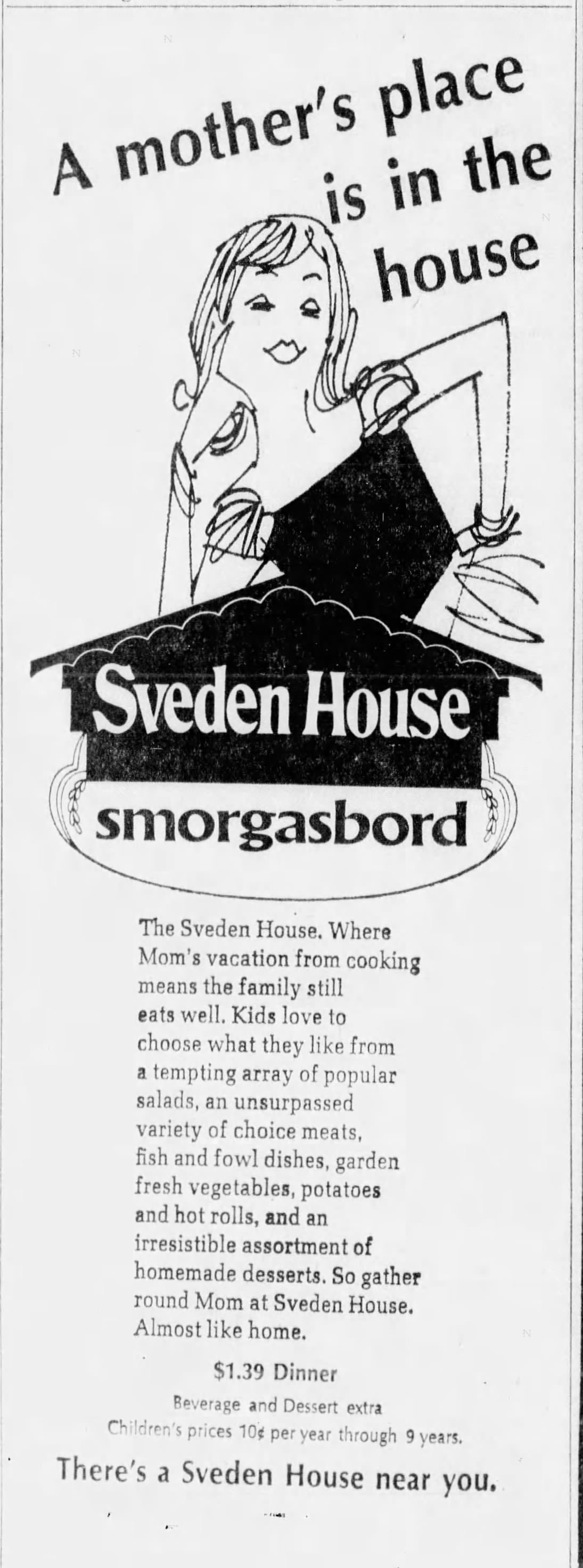
Before IKEA brought its cafeterias to the U.S. in 1985, there was another option for steam-table Swedish meatballs: Sveden House Smorgasbord. In 1964 or ‘65, Sveden House Smorgasbord restaurants shot up all over, with locations across the Twin Cities, several cities in Michigan, and throughout the Midwest. Photos in the Lansing State Journal show a definitive mid-century dining room; it feels like a missed opportunity that Sveden House, with its spelling that forces you to speak in a fake Scandinavian accent, didn’t get a storyline on Mad Men.
Sveden House Smorgasbord provided first jobs to many Twin Cities teenagers in the 60s and 70s, and while they all received on-the-job experience, some got the added bonus of an eye-popping education.
In the Historic Minneapolis Minnesota group on Facebook, Tom Lyman wrote:
“While in high school in 1968, I worked at The Sveden House Smorgasbord, on 5th St S. between Hennepin Ave. and Nicollet Ave. The rear door of this building led to an alley that ran between 4th St. S. and 5th St. S. Each day before closing, we needed to dump all the trash containers into the dumpsters (white elephants) in this alley. None of us guys who worked there wanted this chore. After a while, one guy started doing this chore and not complaining about it. It took the rest of us to watch and see what he was up to. It was summertime. The rear door of The Copper Squirrel Bar, 413 Hennepin Ave, was wide open. There was a three-piece band playing music. Us teenage boys could watch the exotic dancers strip. Some of the dancers never said anything about us watching. Some dancers would make a sign to the bouncers at the front of the bar about us. By the time the bouncer would get to the back of the bar near the stage, we would already be across the alley and into the building with the door shut. This door had a peephole in the door. So one of us could look out the peephole to make sure the bouncer went back in the bar, before we came back out. Not too bad of a job for a bunch of 15-year-olds and getting paid about $1.15 an hour.”
By contrast, the Sveden House Smorgasboard was a family joint, which meant no dress code and no alcohol. No strippers, either, and yet the female servers had to wear “Swedish maid” outfits while ushering diners through the salad bar.

The Food
“Smorgasbord” is a bastardized word here in the U.S. We use it like it’s a synonym for buffet, as if you can line a table with any old array of food and still call it a smorgasbord. In Sweden, a smörgåsbord comprises a particular lineup of dishes. As Christy Hobart writes in Saveur:
A traditional smorgasbord has five parts, to be visited in order—requiring five trips to the table. The first part offers a variety of herring (including, at Christmas, sillsallad—beet and herring salad), sharp cheese, and boiled potatoes. The second is dedicated to cold fish and shellfish dishes like poached and smoked salmon, gravlax, smoked eel, and shrimp and cucumber salad. The third offers meat dishes at room temperature: cold cuts, pates, roasted reindeer, little sausages. Next are warm foods such as Jansson's temptation, herring gratin, meatballs, and, at Christmastime, ham, lutefisk, and creamed kale. The last trip to the smorgasbord is for desserts such as cakes, puddings, more cheese, and fresh fruit.
There was no smoked eel at Sveden House. A full-page ad in a November 1970 edition of the Minneapolis Star touted Maryland fried chicken, Yankee pot roast, fried shrimp, chow mein, roast turkey, Southern barbecued ribs, and something called Baron of Beef, which was “seasoned with salt, pepper and bay leaf and cooked to perfection.”
A Sveden House employee would stand at a table, lopping off slices of the Baron from 5 to 8:30 every weeknight, and from 11 am to 7 pm on Sundays. This was, naturally, a man’s job.
Desserts included “flaming” Baked Alaska as well as pies and cakes.
On balance, diners may have preferred smoked eel. In January 1975, Minneapolis Star staff writer Joe Blade went around reviewing Twin Cities smorgasbords. He wrote, “The Twin Cities’ Scandinavian heritage has left us with a fortunate history of smorgasbord and all-you-can-eat restaurants.” (Sigh.) While he reported enjoying the food at the Anchor Inn, where he was almost “done in” by a platter of onion rings, the Swiss Chalet met with far less approval.
“The Swedish meatballs were cold,” he wrote, damningly. He went on to say, “Sadly, two Minneapolis-area Sveden House restaurants offer nothing like the Anchor Inn’s or Swiss Chalet’s quality of food. Nor quantity.”
Wait. Worse than cold Swedish meatballs? Hold on to your butts, readers.
“I found overcooked vegetables and underflavored salads,” Blade wrote. “The fried chicken was overcooked, tough, dry and greasy. There were bland chicken and dumplings, a spicy sausage and a standard sauerkraut with wurst.” He did find a couple of dishes he liked: a braised beef stew and a “strong, spicy” chili.
Is it any wonder that financial trouble was just around the corner?
The Outfits
An article in the Lansing State Journal says the Swedish maid outfits were sexist by today’s standards (shocker) and that they consisted of “a blue dress with ruffles at the top, a white shirt with puffy sleeves underneath and a white apron. They also had to wear white shoes and nylons.” (No rickrack? How do you have an ersatz ethnic costume without any rickrack?!) When Halloween came around, many of the girls repurposed their uniforms as costumes.
The Advertising
Sveden House spent a lot of money on advertising. When you search for “Sveden House” in newspaper archives, the results are choked with ads. The purpose of advertising is to tell stories, but sometimes, the ads weave a different tale than they’re supposed to.
Ads promoting “inflation-busting” lowered prices, sweepstakes contests that could net you a new bike or a 17-day trip to Scandinavia, and “Mexican nights” all reeked of desperation.
The standout, though, is this one from 1968:
“A mother’s place is in the house”? Like Jerry Seinfeld, who took offense at Tim Watley’s Jewish jokes as a comedian, this offends me not as a woman, but as a copywriter. First of all, the whole “give Mom a night off” angle is so tired. And don’t give me “it was 1968!” It was tired then, too. See: The Burger Chef arc on Mad Men. Note how Peggy Olson does not say a word about letting Mom step away from the stove for a night.
Second of all, Mom’s place is in a house with chicken that is somehow both dry and greasy, and not a Sauv Blanc in sight? Mama don’t play like that.
The End
It’s not clear how closely related the Michigan and Minnesota locations were. While they had separate ownership (International Multifoods owned the Twin Cities locations, while a Michigan source claims Keith and Helen Maxwell owned the restaurants there), they shared similar branding, a motif featuring a muffin-shaped house with a scalloped-edge frieze board. (Later on, newer branding featured two little hearts over the e, and new locations went up without the Scandinavian cabin look affixed to the exterior.)
What is clear is that the Michigan locations were able to hold on a lot longer than the Minnesota ones. The Lansing State Journal reported that the Michigan Sveden House restaurants came to an end “some time in the late 80s or early 90s.”
In Minnesota, it was a different story. In September of 1976, the Minneapolis Tribune reported that “the 32-unit Sveden House operation continues to operate below expectations.” A spokesman from International Multifoods said they weren’t planning to sell it, but also had no plans to expand it.
Less than a year later, in May 1977, the Minneapolis Star reported that Multifoods had closed or sold several Sveden House restaurants, leaving it with just “two company-owned locations and 18 franchised units.” (I’m guessing Keith and Helen Maxwell bought the Michigan locations at this point, but have not been able to verify that.) The article went on to say that, going forward, International Multifoods would steer its investments toward Boston Sea Party restaurants and was planning a “substantial” expansion of its Mister Donut stores.
By 1978, Multifoods was down to its last company-owned Sveden House. That same year, guests at a Sveden House in Flint, Michigan, contracted salmonella and brought legal action in 1980. The Flint Journal reported that it was the seventh food poisoning lawsuit against the restaurant. While this particular Sveden House was unconnected to the Sveden House chain, repeated food poisonings couldn’t have been good for any restaurant operating under that name.
In 1979, the Duluth Herald featured a nostalgic tidbit: “From the Herald of this week in 1969: the Sveden House here offered a smorgasbord dinner for $1.79.”
Six years later, the IKEA invasion would begin.
Author’s note: Recently, a commenter on Facebook pointed out that the Star and Tribune newspapers did not merge until 1980 and I was mistakenly citing articles from the Star Tribune that should’ve been attributed to either the Minneapolis Star or Minneapolis Tribune newspapers. I have made the effort to avoid this error in this post.





This was fun. (I've some Swedish heritage, too ... see last name...). I definitely knew the word smorgasbord growing up, though I don't recall there being any Swedish-themed restaurants where I grew up in southern California in the 60s. Minnesota having a bunch isn't surprising at all, though.
That parking garage pic with the Sveden House in the corner -- sure do wonder if they just didn't want to sell and the garage was built around them. Clearly a period photo, what with the phone booth and 25 cents to park.
The 1980s was a big time for morning and evening newspapers to merge -- the one I remember from living in Seattle at the time was the Times and the P.I. (Post Intelligencer). I can't get too worked up about which one needs the attribution.
I will say that, having been a teenager in the 60s, that "mom's night off" might have been more common than you think!
Really enjoyed this. My mother was Swedish, she would have gotten a kick out of this.